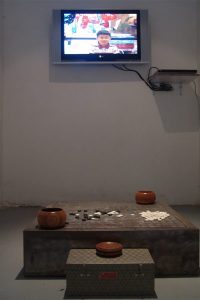25000 TAGS
Building Code Violations I
Location: Long March Space, Beijing (formerly known as 25000 Cultural Transmission Center)
Duration: Apr 8 – May 16, 2006
Artists: Guo Fengyi, Hu Xiangcheng, Lu Jie, Qiu Zhijie, Wang Gongxin, Xu Zhen, Yang Shaobin, Zhan Wang, Zhao Gang, Zheng Guogu, Zhou Xiaohu. an anonymous artist
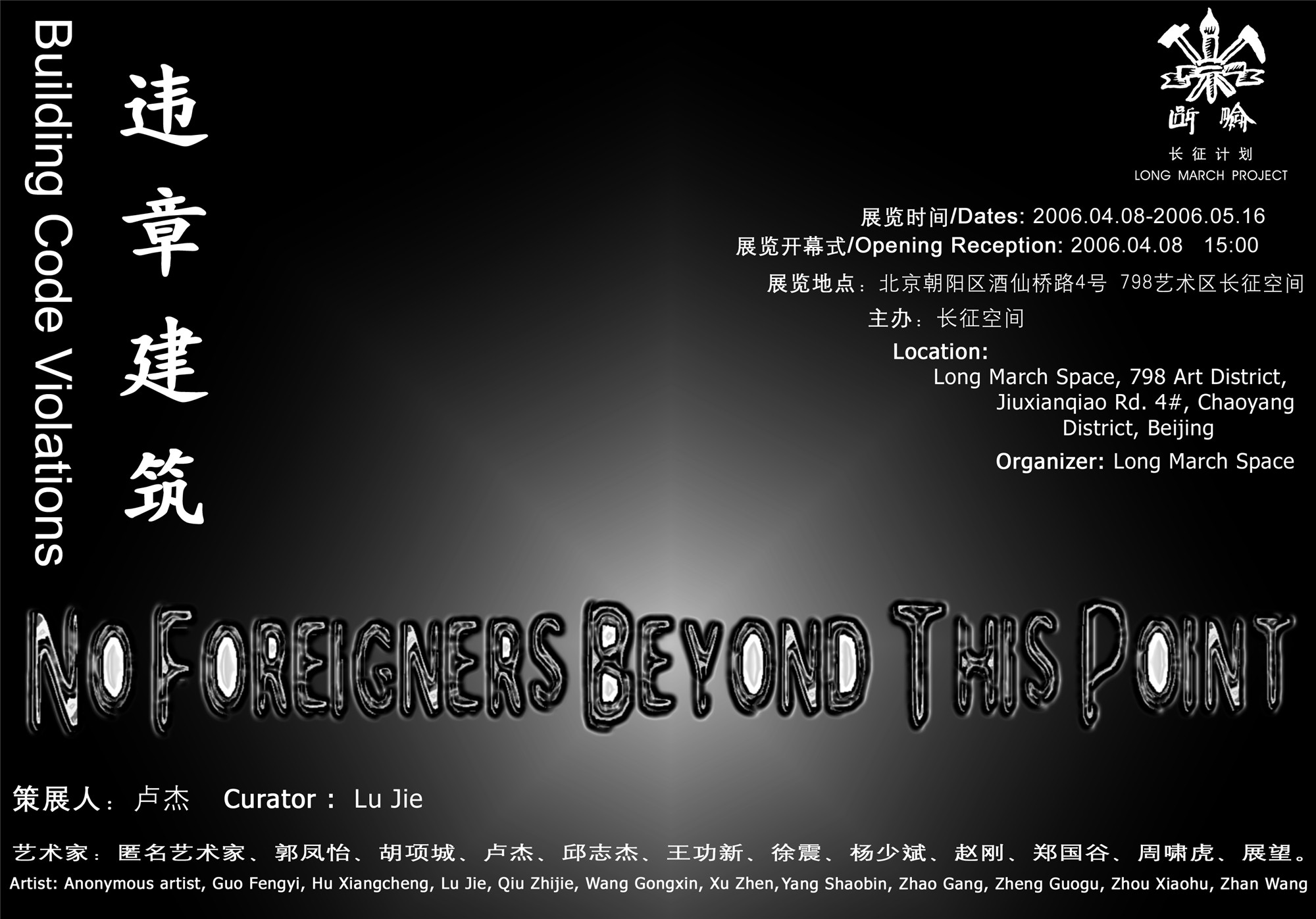
The major Long March exhibition of this year involving the leading artists working in several different mediums. The exhibition examines the concept of “Building Code Violations”, and its different social and cultural implications. “Building code violations” are part of a common legal lexicon of official urban planning departments describing those “independently” executed actions which go against a formalized building standard. Taken as a theme, Building Code Violations represents an experimental site within real social contexts where an ongoing struggle between local knowledge and external “codes” is enacted. Who determines the reality of these codes? What knowledge systems and values are these understandings based upon? Has the “code” of market liberalism triumphed in China, or are there other models of community present to us?
Modernity reconfigures space and landscape so as to be conducive to the organization of production, only to find what it has created to be antagonistic to its needs at a future point in time, thus beginning a process of tearing down and building anew. This process is enacted culturally through the paradoxical turning of temporary constructions into permanent ones, and permanent constructions into building code violations.
Installation View
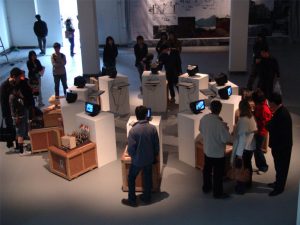
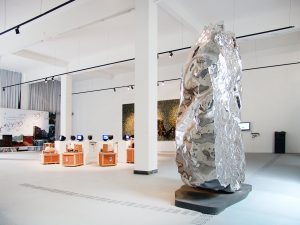
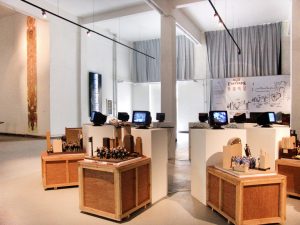
Guo Fengyi
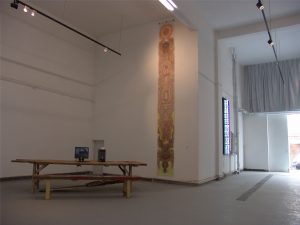
Guo Fengyi, Fengshui of China
Guo Fengyi, a 63-year-old woman artist with psychic powers, is presenting a drawing performance called Fengshui of China. Her work is informed by the concept of the Dao (The Way), a worldview that originated in ancient China. Daoism, which appears throughout China sought a way to balance between humankind and nature, a different concept of understanding a utilizing space. This work is not just a Daoist experiment but an exploration of different places in China, which are both under the influence of the same philosophy. All made in Xi’an, Sha’anxi Province 2005.
Hu Xiangcheng
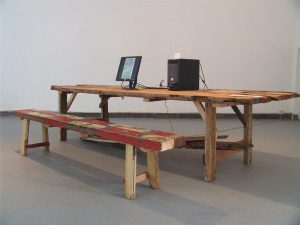
Hu Xiangcheng, Building Code Violations,2006
Artist Hu Xiangcheng is one of the first avant-garde artists after the Cultural Revolution. At the height of his career, he left the art world to begin work on rural reconstruction. This work shows the artist’s work and research in the outlying rural areas surrounding Shanghai. The concept of Building Code Violations connotes “mobile”, “alterable”, and “passive”, it is the resistance and dissolution of “ordinary life” against the “ordinary” and normalized system. Within this limited creativity there lies a critical relationship between “passive” and “subjective”. Building Code Violations is a immanent concept. Within the conversion of “reason” to “law”, there is hidden an extravagant process within the physical and psychological needs of human life. What is embedded within the very space around us is the conflict between the lived experiences of human beings, and the representation of space within society. What is the corresponding “correctness” that actualizes the a “violation”? When the survey of building code violations by Hu Xiangcheng, and documentation of his rural construction work is exhibited as an “artwork”, it becomes a “building code violation” of mistakenly entering into another territory. The margins and permeability between artists/non-artist and work/non-work, explodes the contradictions of space.
Lu Jie
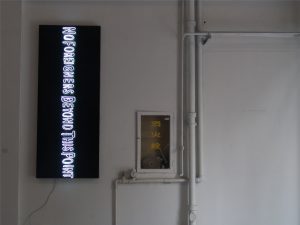
Lu Jie, No Foreigners Beyond this Point
Qiu Zhijie
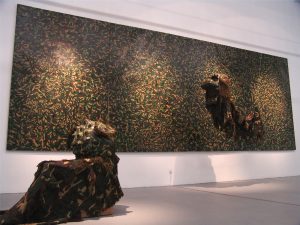
Qiu Zhijie, Slowly Approaching,2005
A powerful work commissioned by the Long March for the Yokohama Triennale. The work features 2 lion costumes made with military camouflage, which were used to perform a traditional lion dance on the streets of the Yokohama Chinatown. The documentary video of this performance, along with the installation will be shown for the first time in China.
Wang Gongxin
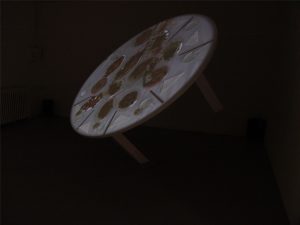
Wang Gongxin, 45° Dinner,Specially Commissioned Work by the Long March
Wang Gongxin is widely recognized as one of the leading Chinese artists working mainly with video installations on myths between the USA and China, children and parents, real and unreal. Wang Gongxin has been quite concerned with the interface between Chinese and Western culture, in terms of content and of his transmission of “Western” artistic ideas to his peers.
Wang Gongxin’s work has been seen at the 2001 Venice Biennial (Italy), the 2001 Sao Paolo Biennial (Brazil), and the 2002 Guangzhou Triennial (China). His videos have also been shown at museums throughout Europe. Wang Gongxin was also included in the 18th worldwide video festival in the Netherlands. For this exhibition, the Long March will commission a new piece by the artist.
Xu Zhen
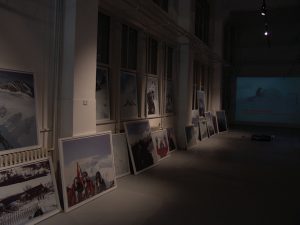
Xu Zhen, 8848—1.86
Commissioned by Long March for the 2005 Yokohama Triennale – Long March Chinatown Project
For this work, the artist claims to have travelled up 8848 meters to the top of Mount Everest and cut off the top 1.86 meters and bringing the mountain to the Yokohama Triennale site. The work is a massive installation consisting of the mountain and refrigerator unit, assorted mountain climbing equipment and articles, photographs, and video documentary.
Yang Shaobin
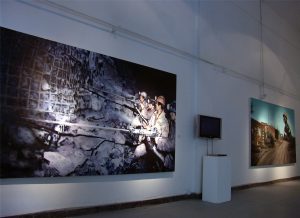
Yang Shaobin, 800 Meters Under, 2004-2006
“800 Meters” is a collaboration between the renowned artist Yang Shaobin and the Long March. Over the course of a two and a half years, the artist traveled to Kailuan Coalmine, the place where he was born and raised, exploring the dialectic relationships between China and the West, revolutionary memory and historical memory, industrial and rural societies, with his personal bodily experiences and history acting as a starting point to revisit the relationship between contemporary art and society, and collective and individual.
Zhan Wang
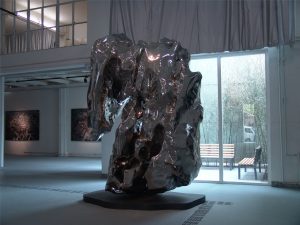
Zhan Wang,Artificial Rock #45
Zhao Gang

Zhao Gang, The Harlem School of New Social Realism, 2002-2005
This is a work that reveals the Long March’s contradictions and problems. Idealism and reality, knowledge and society, self and public are the problems encountered by the historical Long March, and it is also the challenge that today’s Long March is faced with. The work is regarding a discussion between a group of black and Asian artists and thinkers in America that ultimately ends without a conclusion in a discussion regarding black artist from America joining the Long March. The process of the meeting and its final result is the performance of a failed idealism.
Zheng Guogu
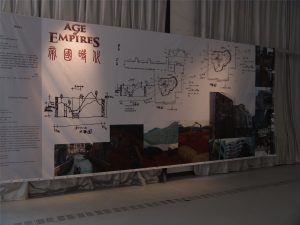
Zheng Guogu, Age of Empires
The project originally started as renewed visit of an intellectual to the countryside. In 2001, I purchased a plot of land approximately 20,000 sq. meters in the area in the village of Yangjiang, and just like that, a game I was playing only in my imagination became a game in reality. I began building stone walls, ponds, planting trees and grass, digging up rocks
building houses, carving rivers and grottos, and building mountains. At the same time, it was a project to become a “rural site”, a non-rural inhabitant becoming a rural inhabitant. This entire process slowly gained legal recognition. Here, I have brought a small detail of the work into urban space, in honour of the return of knowledge.
Zhou Xiaohu
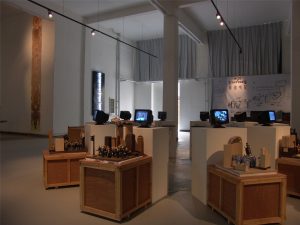
Zhou Xiaohu, Crowd of Bystanders
Zhou Xiaohu’s newest video work is “Crowd Around” ten video dramas by Zhou Xiaohu, created during 2003-2005. Zhou has taken images from the media that have made a deep impression on him. He has created with small clay figures, ten mini vignettes: 1) King of the Box, 2) Clean off Eroticism, 3) 9/11, 4) Hold A Court (Saddam’s trial), 5) Assassin, 6) Safety Education, 7) Traffic Accident, 8) Procreate, 9) Electrocution, and 10) Temple. Zhou says “because of the overflow of information today in the media, the shocking actualities that we see nightly on our TV’s has become entertainment.” In all these video animations, Zhou does not take a position but rather chooses to let the viewer interpret each vignette in his or her own way.
Anonymous project
Anonymous project,Twenty One Go, 2005
The game of Go is a shared cultural symbol and resource between China, Japan, and Taiwan. Today, while the three areas are linked together through mutual and economic and cultural exchange, there still resides an irresolvable geopolitical conflict. “21 Go” is a cultural proposal that looks to resolve this deadlock by taking “another road.” Whereas the actual game of Go is composed of 19 lines, the artist adds an additional column to use a whimsical method of a game to give form to an extremely sensitive and also seemingly helpless political and economically existent conflict, as well as possibly existent benefits of cooperation. The work is performed with one Chinese, one Taiwanese and one Japanese Go chess player between the age of 5-12. On display will be the artist’s installation work as well as the video of live match play.

The major Long March exhibition of this year involving the leading artists working in several different mediums. The exhibition examines the concept of “Building Code Violations”, and its different social and cultural implications. “Building code violations” are part of a common legal lexicon of official urban planning departments describing those “independently” executed actions which go against a formalized building standard. Taken as a theme, Building Code Violations represents an experimental site within real social contexts where an ongoing struggle between local knowledge and external “codes” is enacted. Who determines the reality of these codes? What knowledge systems and values are these understandings based upon? Has the “code” of market liberalism triumphed in China, or are there other models of community present to us?
Modernity reconfigures space and landscape so as to be conducive to the organization of production, only to find what it has created to be antagonistic to its needs at a future point in time, thus beginning a process of tearing down and building anew. This process is enacted culturally through the paradoxical turning of temporary constructions into permanent ones, and permanent constructions into building code violations.
Installation View



Guo Fengyi

Guo Fengyi, Fengshui of China
Guo Fengyi, a 63-year-old woman artist with psychic powers, is presenting a drawing performance called Fengshui of China. Her work is informed by the concept of the Dao (The Way), a worldview that originated in ancient China. Daoism, which appears throughout China sought a way to balance between humankind and nature, a different concept of understanding a utilizing space. This work is not just a Daoist experiment but an exploration of different places in China, which are both under the influence of the same philosophy. All made in Xi’an, Sha’anxi Province 2005.
Hu Xiangcheng

Hu Xiangcheng, Building Code Violations,2006
Artist Hu Xiangcheng is one of the first avant-garde artists after the Cultural Revolution. At the height of his career, he left the art world to begin work on rural reconstruction. This work shows the artist’s work and research in the outlying rural areas surrounding Shanghai. The concept of Building Code Violations connotes “mobile”, “alterable”, and “passive”, it is the resistance and dissolution of “ordinary life” against the “ordinary” and normalized system. Within this limited creativity there lies a critical relationship between “passive” and “subjective”. Building Code Violations is a immanent concept. Within the conversion of “reason” to “law”, there is hidden an extravagant process within the physical and psychological needs of human life. What is embedded within the very space around us is the conflict between the lived experiences of human beings, and the representation of space within society. What is the corresponding “correctness” that actualizes the a “violation”? When the survey of building code violations by Hu Xiangcheng, and documentation of his rural construction work is exhibited as an “artwork”, it becomes a “building code violation” of mistakenly entering into another territory. The margins and permeability between artists/non-artist and work/non-work, explodes the contradictions of space.
Lu Jie

Lu Jie, No Foreigners Beyond this Point
Qiu Zhijie

Qiu Zhijie, Slowly Approaching,2005
A powerful work commissioned by the Long March for the Yokohama Triennale. The work features 2 lion costumes made with military camouflage, which were used to perform a traditional lion dance on the streets of the Yokohama Chinatown. The documentary video of this performance, along with the installation will be shown for the first time in China.
Wang Gongxin

Wang Gongxin, 45° Dinner,Specially Commissioned Work by the Long March
Wang Gongxin is widely recognized as one of the leading Chinese artists working mainly with video installations on myths between the USA and China, children and parents, real and unreal. Wang Gongxin has been quite concerned with the interface between Chinese and Western culture, in terms of content and of his transmission of “Western” artistic ideas to his peers.
Wang Gongxin’s work has been seen at the 2001 Venice Biennial (Italy), the 2001 Sao Paolo Biennial (Brazil), and the 2002 Guangzhou Triennial (China). His videos have also been shown at museums throughout Europe. Wang Gongxin was also included in the 18th worldwide video festival in the Netherlands. For this exhibition, the Long March will commission a new piece by the artist.
Xu Zhen

Xu Zhen, 8848—1.86
Commissioned by Long March for the 2005 Yokohama Triennale – Long March Chinatown Project
For this work, the artist claims to have travelled up 8848 meters to the top of Mount Everest and cut off the top 1.86 meters and bringing the mountain to the Yokohama Triennale site. The work is a massive installation consisting of the mountain and refrigerator unit, assorted mountain climbing equipment and articles, photographs, and video documentary.
Yang Shaobin

Yang Shaobin, 800 Meters Under, 2004-2006
“800 Meters” is a collaboration between the renowned artist Yang Shaobin and the Long March. Over the course of a two and a half years, the artist traveled to Kailuan Coalmine, the place where he was born and raised, exploring the dialectic relationships between China and the West, revolutionary memory and historical memory, industrial and rural societies, with his personal bodily experiences and history acting as a starting point to revisit the relationship between contemporary art and society, and collective and individual.
Zhan Wang

Zhan Wang,Artificial Rock #45
Zhao Gang

Zhao Gang, The Harlem School of New Social Realism, 2002-2005
This is a work that reveals the Long March’s contradictions and problems. Idealism and reality, knowledge and society, self and public are the problems encountered by the historical Long March, and it is also the challenge that today’s Long March is faced with. The work is regarding a discussion between a group of black and Asian artists and thinkers in America that ultimately ends without a conclusion in a discussion regarding black artist from America joining the Long March. The process of the meeting and its final result is the performance of a failed idealism.
Zheng Guogu

Zheng Guogu, Age of Empires
The project originally started as renewed visit of an intellectual to the countryside. In 2001, I purchased a plot of land approximately 20,000 sq. meters in the area in the village of Yangjiang, and just like that, a game I was playing only in my imagination became a game in reality. I began building stone walls, ponds, planting trees and grass, digging up rocks
building houses, carving rivers and grottos, and building mountains. At the same time, it was a project to become a “rural site”, a non-rural inhabitant becoming a rural inhabitant. This entire process slowly gained legal recognition. Here, I have brought a small detail of the work into urban space, in honour of the return of knowledge.
Zhou Xiaohu

Zhou Xiaohu, Crowd of Bystanders
Zhou Xiaohu’s newest video work is “Crowd Around” ten video dramas by Zhou Xiaohu, created during 2003-2005. Zhou has taken images from the media that have made a deep impression on him. He has created with small clay figures, ten mini vignettes: 1) King of the Box, 2) Clean off Eroticism, 3) 9/11, 4) Hold A Court (Saddam’s trial), 5) Assassin, 6) Safety Education, 7) Traffic Accident, 8) Procreate, 9) Electrocution, and 10) Temple. Zhou says “because of the overflow of information today in the media, the shocking actualities that we see nightly on our TV’s has become entertainment.” In all these video animations, Zhou does not take a position but rather chooses to let the viewer interpret each vignette in his or her own way.
Anonymous project
Anonymous project,Twenty One Go, 2005
The game of Go is a shared cultural symbol and resource between China, Japan, and Taiwan. Today, while the three areas are linked together through mutual and economic and cultural exchange, there still resides an irresolvable geopolitical conflict. “21 Go” is a cultural proposal that looks to resolve this deadlock by taking “another road.” Whereas the actual game of Go is composed of 19 lines, the artist adds an additional column to use a whimsical method of a game to give form to an extremely sensitive and also seemingly helpless political and economically existent conflict, as well as possibly existent benefits of cooperation. The work is performed with one Chinese, one Taiwanese and one Japanese Go chess player between the age of 5-12. On display will be the artist’s installation work as well as the video of live match play.

